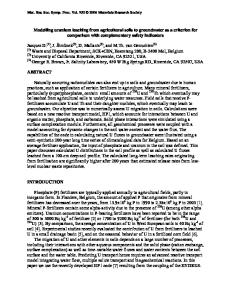Adsorption-desorption and leaching behaviors of broflanilide in four texturally different agricultural soils from China
- PDF / 586,328 Bytes
- 12 Pages / 595.276 x 790.866 pts Page_size
- 35 Downloads / 366 Views
SOILS, SEC 1 • SOIL ORGANIC MATTER DYNAMICS AND NUTRIENT CYCLING • RESEARCH ARTICLE
Adsorption-desorption and leaching behaviors of broflanilide in four texturally different agricultural soils from China Guai Xie 1,2 & Baotong Li 1
&
Limei Tang 1 & Lei Rao 1 & Zeming Dong 1,3
Received: 12 August 2020 / Accepted: 3 November 2020 # Springer-Verlag GmbH Germany, part of Springer Nature 2020
Abstract Purpose Broflanilide (BFL) is a new type of pesticide with broad prospects. However, it is not yet fully understood. With its wide application in the paddy field, it might pose a threat to the environment. Therefore, it is necessary to research its environmental behaviors including adsorption-desorption and leaching behaviors in the soil to evaluate its risks on that basis. Materials and methods Soil samples were obtained from the farmland surface layer in four different regions of China. Adsorption-desorption experiments were conducted according to the equilibrium oscillation method and OECD guidelines. Leaching experiments were designed on the basis of the OECD guidelines. Based on the guidelines of CIPAC, the proposed method was verified and calibrated. BFL residue was analyzed using UHPLC-ESI-QTOF-MS. Results and discussion The Freundlich model was used to fit the BFL’s adsorption-desorption parameters in all soil samples with adsorption constant of BFL ranging from 0.152 to 5.017. The decreasing trends of the BFL adsorption capacity are Phaeozems > > Anthrosols > Gleysols > Luvisols. A linear positive correlation of BFL’s Freundlich desorption and adsorption between organic matter content (R2 = 0.893 and 0.851) and soil clay content (R2 = 0.765 and 0.686). Nevertheless, nonsignificant relationships (R2 = 0.428 and 0.384) between the BFL parameter and the cation exchange capacity of soils were observed. Moreover, soil pH exhibits negative relationships (R2 = 0.095 and 0.089) with BFL’s adsorption and desorption constants. Furthermore, either above or below 287 K reduced the adsorption capacity of BFL by soil. The leaching of BFL in Anthrosols, Gleysols, and Luvisols was easy, while difficult for Phaeozems. Conclusion Except for Phaeozems which contain high organic matter, BFL posed threats to groundwater and surface water owing to their either intermediate or high mobility within the soils in the agriculture system. Keywords Broflanilide . Soil . Adsorption . Desorption . Freundlich model . Leaching
Abbreviations GCB Graphitized carbon black C18 Octadecylsilane
Responsible editor: Xilong Wang * Baotong Li [email protected] 1
College of Agriculture, Jiangxi Agricultural University, 1225 Zhimin Road, Economic and Technological Development Area, Nanchang, China
2
Jiangxi Academy of Forestry, 1629 West Fenglin Road, Economic and Technological Development Area, Nanchang, China
3
Jiangxi Institute for Veterinary Drug and Feedstuffs Control, 689 5th Gaoxin Road, Aixi Lake Management Office, Nanchang, China
PSA QuEChERS
N-Propylethylenediamine The quick, easy, cheap, effective, rugged, and safe method CEC Soil cati
Data Loading...











